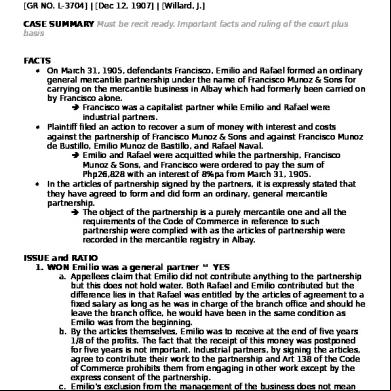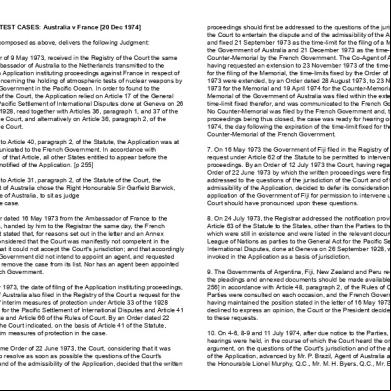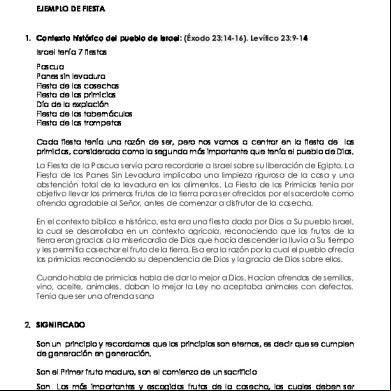Speech Coding Techniques 17116
This document was ed by and they confirmed that they have the permission to share it. If you are author or own the copyright of this book, please report to us by using this report form. Report 3i3n4
Overview 26281t
& View Speech Coding Techniques as PDF for free.
More details 6y5l6z
- Words: 1,897
- Pages: 38
Speech Coding Techniques 潘奕誠 4/7/2003
Introduction
Efficient speech-coding techniques
Advantages for VoIP Digital streams of ones and zeros The lower the bandwidth, the lower the quality
RTP payload types Processing power
The better quality (for a given bandwidth) uses a more complex algorithm A balance between quality and cost
Voice Quality
Bandwidth is easily quantified
Voice quality is subjective
MOS, Mean Opinion Score
ITU-T Recommendation P.800
Excellent – 5 Good – 4 Fair – 3 Poor – 2 Bad – 1
A minimum of 30 people Listen to voice samples or in conversations
P.800 recommendations
The selection of participants The test environment Explanations to listeners Analysis of results
Toll quality
A MOS of 4.0 or higher
About Speech
Speech
Model the vocal tract as a filter
Air pushed from the lungs past the vocal cords and along the vocal tract The basic vibrations – vocal cords The sound is altered by the disposition of the vocal tract ( tongue and mouth) The shape changes relatively slowly
The vibrations at the vocal cords
The excitation signal
Speech sounds
Voiced sound
Unvoiced sounds
The vocal cords vibrate open and close Quasi-periodic pulses of air The rate of the opening and closing – the pitch Forcing air at high velocities through a constriction Noise-like turbulence Show little long-term periodicity Short-term correlations still present
Plosive sounds
A complete closure in the vocal tract Air pressure is built up and released suddenly
Voice Sampling
Discrete Time LTI Systems: The Convolution Sum x[n]
x[k ] [n k ]
x[k ]h[n k ]
y[n]
k 1
k
h[n] n
0 1 2 2
0.5
0 1
x[n]
2.5
2
0.5
n
0 1 2 3
y[n] n
Nyquist sampling theorem X c ( j )
s (t )
(t nT )
n N
N
xs (t ) xc (t ) s (t )
S
0 X c ( j )
S
xc (t ) (t nT ) n
2 S ( j ) T S
N
N
S ( S N )
( k )
k
s
Quantization (Scalar Quantization) v1
m0= -A
vk+1
v2
m1
m2 ……
mk
mk+1
vL
mL1
J
mL=A
k+1 Assume | x[n] | A divide the range [ A , A ] into L quantization levels { J1 , J2 , …… Jk ,….. JL } Jk : [mk-1,mk ]
R L=2
each quantization level Jk is represented by a value vk
S = U Jk , V = { v1 , v2 , …… vk ,….. vL }
Non-Uniform Quantization m0 = -A
m1
m2 ……
0
mL=A
Concept : small quantization levels for small x large quantization levels for large x Goal: constant SNRQ for all x
Companding x[n]
F(x)
Uniform Quantization
Uniform Decoder
F1(x)
Compressor …1101…1101… Expandor Compressor + Expandor Compandor F(x) is to specify the non-uniform quantization characteristics
^ x[n]
Non-Uniform Quantization
-law F ( x)
log 1 μ x
A-law
log( 1 μ)
F ( x)
,0 x 1
Ax 1 ,0 x 1 lnA A 1 ln[ A x ] 1 , x 1 1 lnA A
Typical values in practice = 255 , A = 87.6
Types of Speech Codecs
Waveform codecs,source codecs (also known as vocoders),and hybrid codecs.
Speech Source Model and Source Coding G(z), G(), g[n] unvoiced
random sequence generator periodic pulse train generator
G v/u voiced
u[n]
Excitation parameters
1
G(z) = P
1 akz-k k=1
Vocal Tract Model
N
x[n]v/u : voiced/ unvoiced N : pitch for voiced G : signal gain excitation signal u[n] Vocal Tract parameters
Excitation
A good approximation, though not precise enough
{ak} : LPC coefficients formant structure of speech signals
LPC Vocoder(Voice Coder) x[n]
LPC Analysis
{ ak } N,G v/u
Encoder …11011…
N by pitch detection v/u by voicing detection receiver Decoder …11011…
{ ak } N,G v/u
Ex
g[n] G(z)
x[n]
{ak} can be non-uniform or vector quantized to reduce bit rate
G.711
The most commonplace codec Used in circuit-switched telephone network PCM, Pulse-Code Modulation If uniform quantization 12 bits * 8 k/sec = 96 kbps Non-uniform quantization 65 kbps DS0 rate law
North America A-law Other countries, a little friendlier to lower signal levels An MOS of about 4.3
ADPCM(adaptive differential PCM)
DPCM and ADPCM.
ADPCM : Adaptive Prediction in DPCM Adaptive Quantization Adaptive Quantization
Quantization level varies with local signal level [n] = ax[n] x[n] : locally estimated standard deviation of x[n]
G.721:ADPCM-coded speech at 32Kbps. G.726(A-law or law )
16,24,32,40Kbps MOS 4.0 , at 32Kbps
Analysis-by-Synthesis (AbS) Codecs Hybrid codec
Fill the gap between waveform and source codecs The most successful and commonly used Time-domain AbS codecs Not a simple two-state, voiced/unvoiced Different excitation signals are attempted Closest to the original waveform is selected MPE, Multi-Pulse Excited RPE, Regular-Pulse Excited CELP, Code-Excited Linear Predictive
G.728 LD-CELP
CELP codecs
A filter; its characteristics change over time A codebook of acoustic vectors A vector = a set of elements representing various char. of the excitation Transmit Filter coefficients, gain, a pointer to the vector chosen
Low Delay CELP
Backward-adaptive coder Use previous samples to determine filter coefficients Operates on five samples at a time Delay < 1 ms Only the pointer is transmitted
1024 vectors in the code book 10-bit pointer (index) 16 kbps
LD-CELP encoder
Minimize a frequency-weighted mean-square error
LD-CELP decoder
An MOS score of about 3.9 One-quarter of G.711 bandwidth
G.723.1 ACELP
6.3 or 5.3 kbps
Both mandatory Can change from one to another during a conversation
The coder
A band-limited input speech signal Sampled at 8 KHz, 16-bit uniform PCM quantization Operate on blocks of 240 samples at a time A look-ahead of 7.5 ms A total algorithmic delay of 37.5 ms + other delays A high- filter to remove any DC component
G.723.1 Annex A
The two lsbs of the first octet
Silence Insertion Description (SID) frames of size four octets 00 01 10
6.3kbps 24 octets/frame 5.3kbps 20 SID frame 4
An MOS of about 3.8
At least 37.5 ms delay
G.729
8 kbps Input frames of 10 ms, 80 samples for 8 KHz sampling rate 5 ms look-ahead
Algorithmic delay of 15 ms
An 80-bit frame for 10 ms of speech A complex codec
G.729.A (Annex A), a number of simplifications Same frame structure Encoder/decoder, G.729/G.729.A Slightly lower quality
G.729.B
VAD, Voice Activity Detection
DTX, Discontinuous Transmission
Based on analysis of several parameters of the input The current frames plus two preceding frames Send nothing or send an SID frame SID frame contains information to generate comfort noise
CNG, Comfort Noise Generation
G.729, an MOS of about 4.0 G.729A an MOS of about 3.7
Other Codecs
CDMA QCELP defined in IS-733
Variable-rate coder Two most common rates
The high rate, 13.3 kbps A lower rate, 6.2 kbps
Silence suppression For use with RTP, RFC 2658
GSM Enhanced Full-Rate (EFR)
GSM 06.60 An enhanced version of GSM Full-Rate ACELP-based codec The same bit rate and the same overall packing structure
12.2 kbps
discontinuous transmission For use with RTP, RFC 1890
GSM Adaptive Multi-Rate (AMR) codec
GSM 06.90 Eight different modes 4.75 kbps to 12.2 kbps 12.2 kbps, GSM EFR 7.4 kbps, IS-641 (TDMA cellular systems) Change the mode at any time Offer discontinuous transmission
The MOS values are for laboratory conditions
G.711 does not deal with lost packets G.729 can accommodate a lost frame by interpolating from previous frames
But cause errors in subsequent speech frames
Processing Power
G.728 or G.729, 40 MIPS G.726 10 MIPS
Cascaded Codecs
E.g., G.711 stream -> G.729 encoder/decoder Might not even come close to G.729
Each coder only generate an approximate of the incoming signal
Tones, Signal, and DTMF The hybrid codecs are optimized for Digits
human speech
Other data may need to be transmitted Tones: fax tones, dialing tone, busy tone DTMF digits for two-stage dialing or voicemail
G.711 is OK G.723.1 and G.729 can be unintelligible The ingress gateway needs to intercept
The tones and DTMT digits
Easy at the start of a call Difficult in the middle of a call
Encode the tones differently form the speech
Send them along the same media path An RTP packet provides the name of the tone and the duration Or, a dynamic RTP profile; an RTP packet containing the frequency, volume and the duration RFC 2198 An RTP payload format for redundant audio data Sending both types of RTP payload
RTP Payload Format for DTMF Digits
An Internet Draft Both methods described before A large number of tones and events
DTMF digits, a busy tone, a congestion tone, a ringing tone, etc.
The named events
E: the end of the tone, R: reserved
Payload format
Finis
Discrete Time LTI Systems: The Convolution Sum x[n]
x[k ] [n k ]
k
y[n]
x[k ]h[n k ]
k 1
h[n] n
0 1 2 2
0.5
0 1
x[n]
2.5
2
0.5
n
0 1 2 3
y[n] n
Frequency-Domain Representation of Sampling X c ( j)
s (t )
(t nT )
n N
N
xs (t ) xc (t ) s (t )
S
0 X c ( j)
S
xc (t ) (t nT ) n
2 S ( j ) T S
N
N
S ( S N )
( k )
k
s
Speech Source Model and Source Coding
Vocal Tract Model u (n) a x[n k ] x[n] p
k 1
G( z)
k
1 p
1 ak z k k 1
X ( z) U ( z)
Introduction
Efficient speech-coding techniques
Advantages for VoIP Digital streams of ones and zeros The lower the bandwidth, the lower the quality
RTP payload types Processing power
The better quality (for a given bandwidth) uses a more complex algorithm A balance between quality and cost
Voice Quality
Bandwidth is easily quantified
Voice quality is subjective
MOS, Mean Opinion Score
ITU-T Recommendation P.800
Excellent – 5 Good – 4 Fair – 3 Poor – 2 Bad – 1
A minimum of 30 people Listen to voice samples or in conversations
P.800 recommendations
The selection of participants The test environment Explanations to listeners Analysis of results
Toll quality
A MOS of 4.0 or higher
About Speech
Speech
Model the vocal tract as a filter
Air pushed from the lungs past the vocal cords and along the vocal tract The basic vibrations – vocal cords The sound is altered by the disposition of the vocal tract ( tongue and mouth) The shape changes relatively slowly
The vibrations at the vocal cords
The excitation signal
Speech sounds
Voiced sound
Unvoiced sounds
The vocal cords vibrate open and close Quasi-periodic pulses of air The rate of the opening and closing – the pitch Forcing air at high velocities through a constriction Noise-like turbulence Show little long-term periodicity Short-term correlations still present
Plosive sounds
A complete closure in the vocal tract Air pressure is built up and released suddenly
Voice Sampling
Discrete Time LTI Systems: The Convolution Sum x[n]
x[k ] [n k ]
x[k ]h[n k ]
y[n]
k 1
k
h[n] n
0 1 2 2
0.5
0 1
x[n]
2.5
2
0.5
n
0 1 2 3
y[n] n
Nyquist sampling theorem X c ( j )
s (t )
(t nT )
n N
N
xs (t ) xc (t ) s (t )
S
0 X c ( j )
S
xc (t ) (t nT ) n
2 S ( j ) T S
N
N
S ( S N )
( k )
k
s
Quantization (Scalar Quantization) v1
m0= -A
vk+1
v2
m1
m2 ……
mk
mk+1
vL
mL1
J
mL=A
k+1 Assume | x[n] | A divide the range [ A , A ] into L quantization levels { J1 , J2 , …… Jk ,….. JL } Jk : [mk-1,mk ]
R L=2
each quantization level Jk is represented by a value vk
S = U Jk , V = { v1 , v2 , …… vk ,….. vL }
Non-Uniform Quantization m0 = -A
m1
m2 ……
0
mL=A
Concept : small quantization levels for small x large quantization levels for large x Goal: constant SNRQ for all x
Companding x[n]
F(x)
Uniform Quantization
Uniform Decoder
F1(x)
Compressor …1101…1101… Expandor Compressor + Expandor Compandor F(x) is to specify the non-uniform quantization characteristics
^ x[n]
Non-Uniform Quantization
-law F ( x)
log 1 μ x
A-law
log( 1 μ)
F ( x)
,0 x 1
Ax 1 ,0 x 1 lnA A 1 ln[ A x ] 1 , x 1 1 lnA A
Typical values in practice = 255 , A = 87.6
Types of Speech Codecs
Waveform codecs,source codecs (also known as vocoders),and hybrid codecs.
Speech Source Model and Source Coding G(z), G(), g[n] unvoiced
random sequence generator periodic pulse train generator
G v/u voiced
u[n]
Excitation parameters
1
G(z) = P
1 akz-k k=1
Vocal Tract Model
N
x[n]v/u : voiced/ unvoiced N : pitch for voiced G : signal gain excitation signal u[n] Vocal Tract parameters
Excitation
A good approximation, though not precise enough
{ak} : LPC coefficients formant structure of speech signals
LPC Vocoder(Voice Coder) x[n]
LPC Analysis
{ ak } N,G v/u
Encoder …11011…
N by pitch detection v/u by voicing detection receiver Decoder …11011…
{ ak } N,G v/u
Ex
g[n] G(z)
x[n]
{ak} can be non-uniform or vector quantized to reduce bit rate
G.711
The most commonplace codec Used in circuit-switched telephone network PCM, Pulse-Code Modulation If uniform quantization 12 bits * 8 k/sec = 96 kbps Non-uniform quantization 65 kbps DS0 rate law
North America A-law Other countries, a little friendlier to lower signal levels An MOS of about 4.3
ADPCM(adaptive differential PCM)
DPCM and ADPCM.
ADPCM : Adaptive Prediction in DPCM Adaptive Quantization Adaptive Quantization
Quantization level varies with local signal level [n] = ax[n] x[n] : locally estimated standard deviation of x[n]
G.721:ADPCM-coded speech at 32Kbps. G.726(A-law or law )
16,24,32,40Kbps MOS 4.0 , at 32Kbps
Analysis-by-Synthesis (AbS) Codecs Hybrid codec
Fill the gap between waveform and source codecs The most successful and commonly used Time-domain AbS codecs Not a simple two-state, voiced/unvoiced Different excitation signals are attempted Closest to the original waveform is selected MPE, Multi-Pulse Excited RPE, Regular-Pulse Excited CELP, Code-Excited Linear Predictive
G.728 LD-CELP
CELP codecs
A filter; its characteristics change over time A codebook of acoustic vectors A vector = a set of elements representing various char. of the excitation Transmit Filter coefficients, gain, a pointer to the vector chosen
Low Delay CELP
Backward-adaptive coder Use previous samples to determine filter coefficients Operates on five samples at a time Delay < 1 ms Only the pointer is transmitted
1024 vectors in the code book 10-bit pointer (index) 16 kbps
LD-CELP encoder
Minimize a frequency-weighted mean-square error
LD-CELP decoder
An MOS score of about 3.9 One-quarter of G.711 bandwidth
G.723.1 ACELP
6.3 or 5.3 kbps
Both mandatory Can change from one to another during a conversation
The coder
A band-limited input speech signal Sampled at 8 KHz, 16-bit uniform PCM quantization Operate on blocks of 240 samples at a time A look-ahead of 7.5 ms A total algorithmic delay of 37.5 ms + other delays A high- filter to remove any DC component
G.723.1 Annex A
The two lsbs of the first octet
Silence Insertion Description (SID) frames of size four octets 00 01 10
6.3kbps 24 octets/frame 5.3kbps 20 SID frame 4
An MOS of about 3.8
At least 37.5 ms delay
G.729
8 kbps Input frames of 10 ms, 80 samples for 8 KHz sampling rate 5 ms look-ahead
Algorithmic delay of 15 ms
An 80-bit frame for 10 ms of speech A complex codec
G.729.A (Annex A), a number of simplifications Same frame structure Encoder/decoder, G.729/G.729.A Slightly lower quality
G.729.B
VAD, Voice Activity Detection
DTX, Discontinuous Transmission
Based on analysis of several parameters of the input The current frames plus two preceding frames Send nothing or send an SID frame SID frame contains information to generate comfort noise
CNG, Comfort Noise Generation
G.729, an MOS of about 4.0 G.729A an MOS of about 3.7
Other Codecs
CDMA QCELP defined in IS-733
Variable-rate coder Two most common rates
The high rate, 13.3 kbps A lower rate, 6.2 kbps
Silence suppression For use with RTP, RFC 2658
GSM Enhanced Full-Rate (EFR)
GSM 06.60 An enhanced version of GSM Full-Rate ACELP-based codec The same bit rate and the same overall packing structure
12.2 kbps
discontinuous transmission For use with RTP, RFC 1890
GSM Adaptive Multi-Rate (AMR) codec
GSM 06.90 Eight different modes 4.75 kbps to 12.2 kbps 12.2 kbps, GSM EFR 7.4 kbps, IS-641 (TDMA cellular systems) Change the mode at any time Offer discontinuous transmission
The MOS values are for laboratory conditions
G.711 does not deal with lost packets G.729 can accommodate a lost frame by interpolating from previous frames
But cause errors in subsequent speech frames
Processing Power
G.728 or G.729, 40 MIPS G.726 10 MIPS
Cascaded Codecs
E.g., G.711 stream -> G.729 encoder/decoder Might not even come close to G.729
Each coder only generate an approximate of the incoming signal
Tones, Signal, and DTMF The hybrid codecs are optimized for Digits
human speech
Other data may need to be transmitted Tones: fax tones, dialing tone, busy tone DTMF digits for two-stage dialing or voicemail
G.711 is OK G.723.1 and G.729 can be unintelligible The ingress gateway needs to intercept
The tones and DTMT digits
Easy at the start of a call Difficult in the middle of a call
Encode the tones differently form the speech
Send them along the same media path An RTP packet provides the name of the tone and the duration Or, a dynamic RTP profile; an RTP packet containing the frequency, volume and the duration RFC 2198 An RTP payload format for redundant audio data Sending both types of RTP payload
RTP Payload Format for DTMF Digits
An Internet Draft Both methods described before A large number of tones and events
DTMF digits, a busy tone, a congestion tone, a ringing tone, etc.
The named events
E: the end of the tone, R: reserved
Payload format
Finis
Discrete Time LTI Systems: The Convolution Sum x[n]
x[k ] [n k ]
k
y[n]
x[k ]h[n k ]
k 1
h[n] n
0 1 2 2
0.5
0 1
x[n]
2.5
2
0.5
n
0 1 2 3
y[n] n
Frequency-Domain Representation of Sampling X c ( j)
s (t )
(t nT )
n N
N
xs (t ) xc (t ) s (t )
S
0 X c ( j)
S
xc (t ) (t nT ) n
2 S ( j ) T S
N
N
S ( S N )
( k )
k
s
Speech Source Model and Source Coding
Vocal Tract Model u (n) a x[n k ] x[n] p
k 1
G( z)
k
1 p
1 ak z k k 1
X ( z) U ( z)










